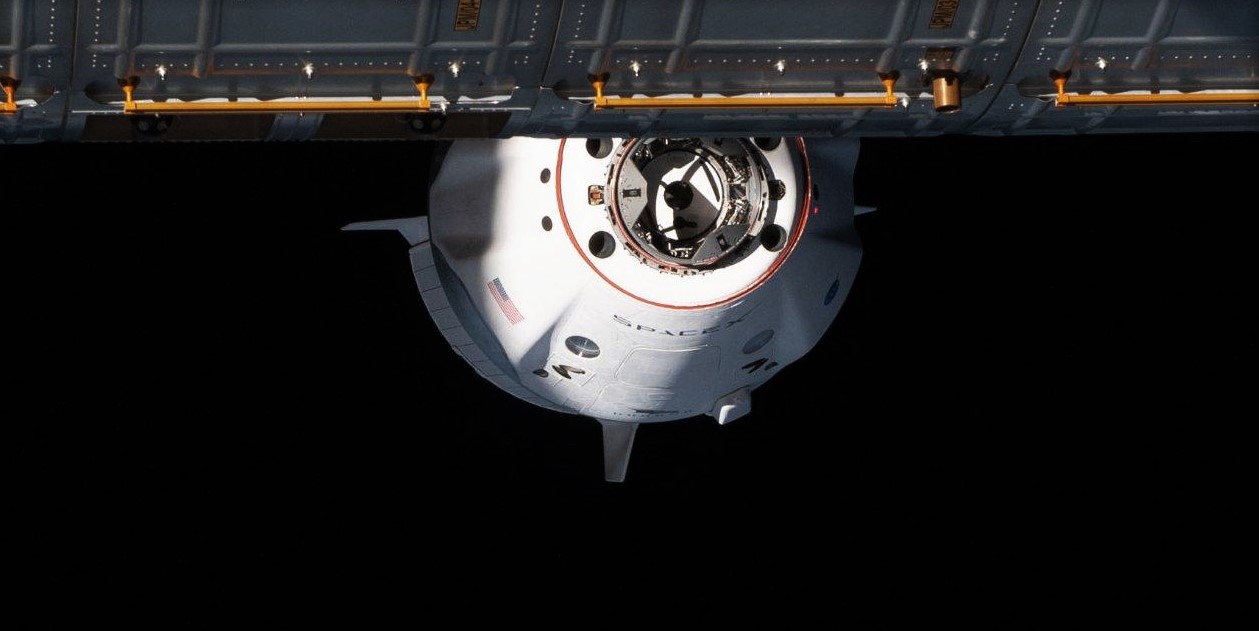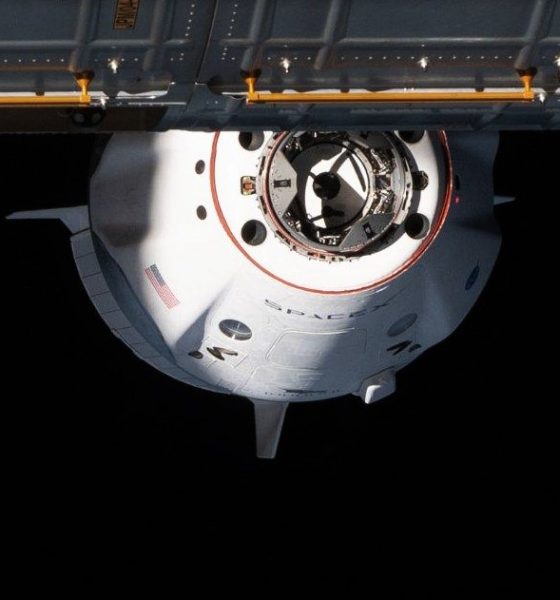

News
SpaceX private astronaut launch debut to reuse Crew-1 Dragon spacecraft
A former NASA astronaut now employed by Axiom Space says that SpaceX’s private astronaut launch debut will reuse the same Crew Dragon spacecraft currently supporting NASA’s Crew-1 mission in orbit.
Currently just a few weeks into a planned six-month stint in orbit, potentially marking the longest uninterrupted flight of an American spacecraft ever, Crew Dragon capsule C207 and an expendable trunk section arrived at the International Space Station (ISS) on November 16th. Known as Crew-1, the mission represents SpaceX and NASA’s commercial operational astronaut launch debut, carrying four astronauts to the ISS.
Crucially, the mission has been an almost flawless success so far and Falcon 9 has now completed four Crew Dragon launches without issue. On the Dragon side of things, the Crew-1 spacecraft performed a bit less perfectly than those tasked with flying Demo-1 and Demo-2, but SpaceX handled the minor issues that arose with the professionalism and composure of a team far more familiar with human spaceflight.

Early success aside, there is still some definite uncertainty ahead of Crew Dragon. While several Russian spacecraft have decades of experience spending at least several months at a time in orbit, a crewed US spacecraft has never spent more than 84 days in orbit. SpaceX itself actually beat out NASA to secure the second-place record with Crew Dragon’s 63-day Demo-2 astronaut launch debut, completed with a successful reentry and splashdown on August 2nd.

However, Crew-1 is expected to more than double that previous US record and almost triple SpaceX’s own second-place record, spending roughly 180 days (six months, give or take) in orbit. Barring an unprecedented space station or spacecraft emergency, Crew Dragon C207 will undock from ISS, reenter Earth’s atmosphere, and splashdown in the Gulf of Mexico or the Atlantic Ocean sometime in May 2021. Of course, as the first recoverable US spacecraft to spend anywhere close to that long in orbit, the Crew-1 Crew Dragon will be closely monitored to ensure the safety and reliability of its intricate reentry and recovery systems after some six months exposed to the extremes of space.
Still, success is by far the likeliest outcome. When Crew Dragon C207 splashes down, its four astronaut passengers will be carefully extricated and the inspection and refurbishment process will begin almost immediately thereafter. Crew-1 will technically be the second Crew Dragon spacecraft to be refurbished after an orbital spaceflight, following Demo-2 capsule C206’s inaugural Dragon 2 reuse perhaps just a month or two prior.

The Demo-2 Crew Dragon capsule is currently scheduled to fly a second time as early as March 31st, 2021 on SpaceX’s Crew-2 mission, ferrying another four astronauts to the ISS. If successful, Crew-2 will represent the first commercial astronaut launch ever to reuse both an orbital-class rocket booster and an orbital spacecraft, and the NASA-overseen process of refurbishment and re-flight will thus pave the way for future flight-proven astronaut launches. That includes private company Axiom Space’s first private AX-1 astronaut launch, which is currently scheduled to launch as early as Q4 2021.
AX-1 will be captained by former NASA astronaut Mike Lopez-Algeria and carry three other private astronauts, including Israeli multimillionaire Eytan Stibbe. SpaceX will thus be tasked with launching Israel’s second astronaut ever after Ilan Ramon was killed when a heat shield design flaw caused NASA Space Shuttle Columbia to break up during reentry in 2003.

News
Tesla FSD successfully completes full coast-to-coast drive with zero interventions
Tesla community members celebrated the milestone on X, and the feat earned praise from some of the electric vehicle maker’s executives.

A Tesla owner has successfully completed a full coast-to-coast drive across the United States on Full Self-Driving (FSD) Supervised. The trip was accomplished with zero interventions.
Tesla community members celebrated the milestone on X, and the feat earned praise from some of the electric vehicle maker’s executives.
FSD Coast-to-Coast
The coast-to-coast feat was accomplished by Tesla owner Davis Moss, who drives a stealth gray Model 3 with AI4 hardware. Based on data from the FSD database and a community tracker, the last 10,638.8 miles Moss drove in his Model 3 were completed using FSD 100% of the time. His vehicle is equipped with FSD v14.2.1.25, which was installed 12 days ago.
As per Moss in a celebratory post on X, his Model 3 was able to complete a full coast-to-coast drive across the United States in 2 days and 20 hours. His trip started at the Tesla Diner in Los Angeles, CA, and it ended in Myrtle Beach, SC. Overall, his trip spanned 2,732.4 miles.
“This was accomplished with Tesla FSD V14.2 with absolutely 0 disengagements of any kind even for all parking including at Tesla Superchargers,” Moss stated in his post. He also added in later comments that there were zero close calls during the trip.
Tesla community celebrates
The FSD milestone trip was widely lauded by members of the Tesla community, especially since a coast-to-coast drive with zero interventions has been cited by Elon Musk as a target since October 2016, when Autopilot 2.0 was unveiled. At the time, Musk initially estimated that a coast-to-coast drive across the United States should be possible by the end of 2017. Considering Moss’ feat in his Model 3, it appears that Elon Musk’s estimate was not impossible at all. It was just late.
Musk himself celebrated the milestone on X, and so did Tesla VP of AI Software Ashok Elluswamy, who wrote “World’s first fully autonomous coast-to-coast drive, done with Tesla self-driving v14. Congrats and thank you @DavidMoss!” in a post on X. The official Tesla North America account also celebrated the feat, writing “First Tesla to drive itself from coast to coast w/ FSD Supervised. 0 interventions, all FSD” on X.
Elon Musk
Elon Musk: Tesla Model Y is world’s best-selling car for 3rd year in a row
The Model Y has now established an impressive streak that would otherwise have been impossible before Tesla.

Elon Musk has announced that the Tesla Model Y has become the world’s best-selling car by volume for the third consecutive year, capping 2025 with another dominant performance.
The Model Y has now established an impressive streak that would otherwise have been impossible before Tesla.
Three years in a row
Musk posted on X: “Tesla Model Y is now officially the world’s best-selling car for the third year in a row!” The CEO’s comment echoed an update that Tesla included in its 2025 recap, which highlighted, among other things, the Model Y’s incredible streak.
The Model Y has held the title since 2023, outperforming traditional leaders like the Toyota RAV4 and Corolla thanks to its bang-for-the-buck nature and its stellar combination of practicality, performance, and tech. The Model Y is also lauded as one of the safest vehicles on the road, making it an ideal choice for families in key markets such as China.
An impressive 2025
The Model Y’s sales feat in 2025 is especially impressive considering the introduction of the vehicle’s new variant. Tesla’s changeover to the new Model Y across its global factories resulted in sales being paused for some time in the first quarter. As per Tesla’s Q1 2025 vehicle delivery and production report, “the changeover of Model Y lines across all four of our factories led to the loss of several weeks of production in Q1.”
This suggests that the Model Y’s sales remained strong in 2025 to the point where it could still claim the title of the world’s best-selling vehicle by volume, even with its sales being throttled during the first quarter of the year. It would then be interesting to see just how far the Model Y can go in 2026, especially considering the rollout of new variants like the six-seat extended wheelbase Model Y L, the affordable Model Y Standard, and the top-tier Model Y Performance.
News
Tesla shares epic 2025 recap video, confirms start of Cybercab production
The cinematic montage, posted by the official Tesla account on X, celebrated the company’s progress in EVs, energy, and Robotaxi development.

Tesla has released an epic year-in-review video for 2025, recapping some of its major achievements from refreshed models to autonomy breakthroughs and production ramps.
The cinematic montage, posted by the official Tesla account on X, celebrated the company’s progress in EVs, energy, and Robotaxi development while looking ahead to an even bigger 2026.
Tesla’s 2025 highlights recap
Tesla has had a busy 2025, as highlighted in the recap video. The video opened with Elon Musk explaining the company’s pursuit of sustainable abundance. A number of milestones were then highlighted, such as the rollout of FSD v14, Optimus’ numerous demos, the opening of the Tesla Diner in Hollywood, LA, the completion of the world’s first autonomous car delivery, and the launch of the Robotaxi network in Austin and the San Francisco Bay Area.
Tesla also highlighted several of its accomplishments over the year. As per the company, the Model Y was the year’s best-selling vehicle globally again, and Teslas became more affordable than ever thanks to the Model 3 and Model Y Standard. Other key models were also rolled out, such as the refreshed Model S and X, as well as the new Model Y, the new Model Y Performance, and the six-seat, extended wheelbase Model Y L.
The Megablock was also unveiled during the year, and the Supercharger Network grew by 18%. Over 1 million Powerwalls were also installed during the year, and the Cybertruck became the first EV truck to get both an IIHS Top Safety Pick+ award and an NHTSA 5-Star safety rating.
Cybercab production confirmed
Interestingly enough, Tesla also confirmed in its 2025 recap video that the production of the Cybercab has started. This bodes well for the vehicle, as it could result in the vehicle really being mass-produced in the first half of 2026. Elon Musk confirmed during the 2025 Annual Shareholder Meeting that Cybercab production should earnestly start around April 2026.
Musk has also noted that the Cybercab will be Tesla’s highest-volume vehicle yet, with the company aiming for an annual production rate of about 2 million units. “If you’ve seen the design of the Cybercab line, it doesn’t look like a normal car manufacturing line,” Musk said earlier this year. “It looks like a really high-speed consumer electronics line. In fact, the line will move so fast that actually people can’t even get close to it.”







